-
CENTRES
Progammes & Centres
Location
 PDF Download
PDF Download 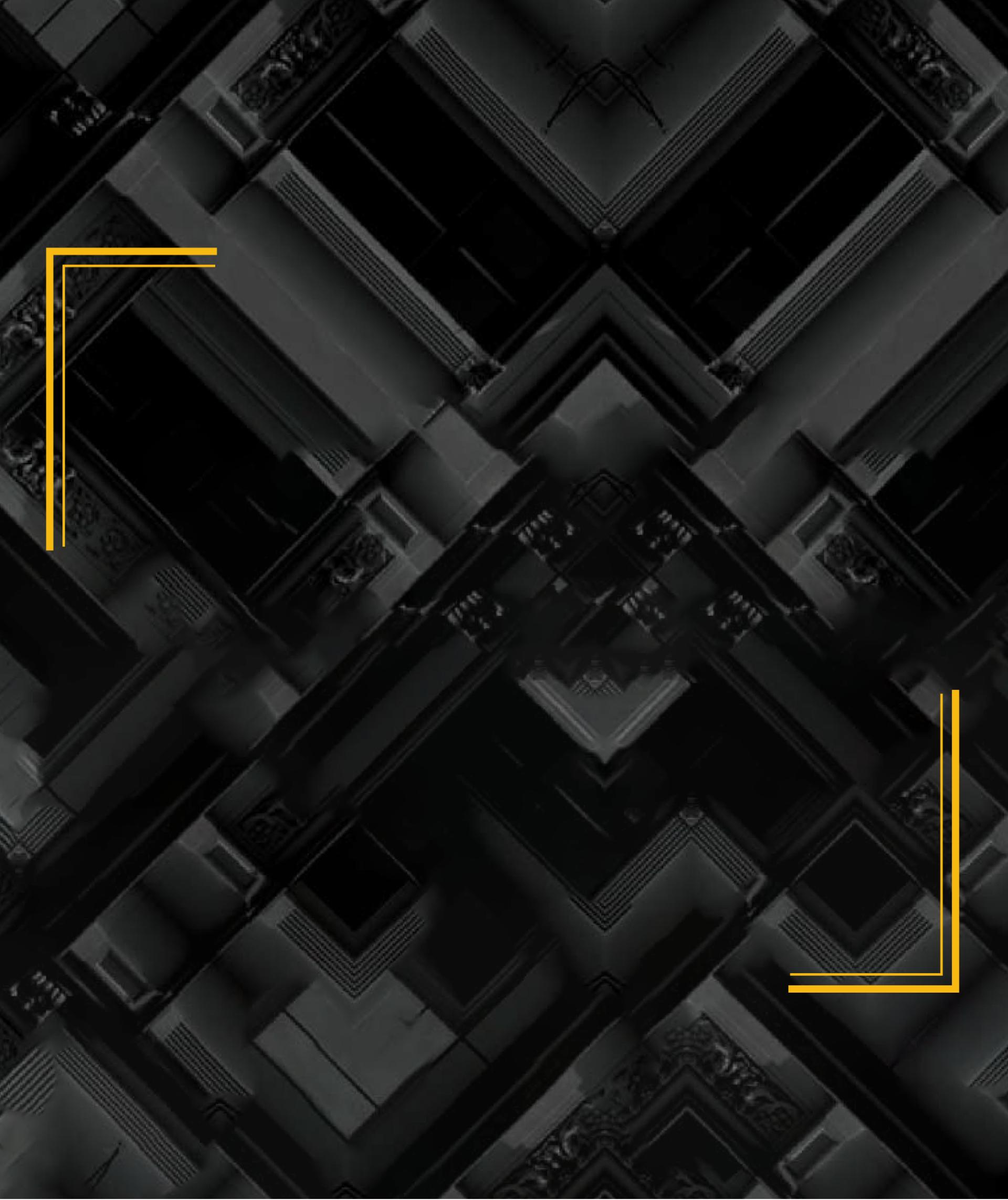
Abhishek Sharma, “Mapping South Korea’s Defence Industrialisation in the Age of Smart Technologies,” ORF Occasional Paper No. 499, Observer Research Foundation, October 2025.
South Korea’s initial defence industrialisation started in the early 1950s, five years after its independence, when it faced a war with North Korea. Nonetheless, some scholars like Peter Banseok Kwon have traced the true origin of the defence industrialisation process to the Yulgok Project, which started in the 1970s under former President Park Chung-hee through a state-led defence indigenisation model.
[1] This first phase of defence industrialisation was driven by heavy chemical industries during the US Forces' withdrawal from Korea owing to the Vietnam War, raising serious security concerns in Seoul for its national defence and pushing policymakers to develop systematic plans for defence industrialisation. Additionally, from the late 1980s, South Korea leveraged imports from the US (United States), the UK (United Kingdom), Italy, and Germany to build its domestic defence manufacturing from scratch via co-production rights and strategic military equipment transfer, such as F-16, Hawk Trainer jets, Type-6614 wheeled-armoured personnel carrier, and submarines.[2] The defence partnership helped accelerate the production of critical military systems and contributed to developing its defence industrial ecosystem.
The second phase of defence industrialisation, ushered in the late 1990s, profoundly impacted the Revolution in Military Affairs (RMA), as opposed to the first phase.[3] This was the period in which warfare shifted from platform-centric to network-centric warfare. The process started with the Roh Tae-woo government in 1988 under his ‘Koreanization of Korean Defense’ slogan and defence policy, which emphasised developing a long-term defence posture plan, but lost pace under the Kim Young-sam administration.[4] However, under the Kim Dae-jung government (1998-2003), concrete steps were taken, establishing the Five-Year Defense Reform Plan and launching the Committee for the Promotion of Defense Reform.[5]
The second phase of defence industrialisation and the serious implementation of RMA occurred in three ways: creating a unified national command system, informing the sector, and acquiring assets related to network-centric warfare.[6] Since then, the efforts of subsequent Presidents, including Roh Moo-hyun, Lee Myung-bak, and Park Geun-hye, have contributed to the efforts of their predecessors. Scholars like Michael Raska have identified that over the past few decades, South Korean RMA diffusion took place along two levels, external and internal. Shaped externally by Korea’s threat perception and changes in US defence transformation, and internally by the changing strategic assessments influenced by the imperatives to develop self-reliant military capabilities.[7] He also characterised the sub-phases of the RMA in the 1990s as initial exploration and adoption, and in the 2000s as emulation and adaptation.[8]
Table 1: The RMA During Phase 2
| 1990s: Speculation and Exploration | 2000s: Emulation and Adaptation |
|
● US RMA started permeating into Korea (Example: The Deep Operations Primer-Korea, Air Ground Operations-Korea, and Joint/Combined Fires-Korea) ● Conceptualisation of long-term force modernisation ● The National Defense Reform Committee (NDRC) was created in 1998 by the ROK Ministry of National Defense. In 1999, the NDRC set up the RMA planning group ● ROK Army, Air Force, and Navy started conceptualising long-term strategies (Example: ROK Air Force’s Air Force Vision 2030) |
● The US Global Defense Posture post-9/11 impacted its allies, including the US-ROK Alliance. ● Launch of the Future of ROK-US Alliance Policy Initiative, focused on assessing existing missions and command structures ● Under President Roh, there was a focus on ‘co-operative self-reliant defense.’ ● Mid-Term Force Improvement Plan (Information Dominance and Omni-Directional Defense) 2003-2007 and Defense Reform Plan 2020 (focused on shifting from manpower-intensive to capability-based RMA-oriented force, and a phase reduction in military workforce by 2020) |
Source: Michael Raska[9]
In the third and latest phase of defence industrialisation, while economic logic is vital, the impact of RMA is increasingly becoming prominent. Recent acquisition and procurement decisions are a few key areas. The changing geopolitical environment in the Indo-Pacific, particularly developments in the Northeast Asian region−an emerging battleground between the US and China−is the first critical factor to have facilitated the RMA. The fourth industrial revolution, which has accelerated the development of New Generation Technologies (NGTs) with dual-use applications, is the second factor that directly impacts RMA. These technologies are AI, semiconductors, robotics, and quantum technologies. The trend is similar to the advent of the third industrial revolution through Information Technology (IT), which brought network-centric warfare and new changes in military structures and doctrines.
Today, a critical phenomenon is taking place that has reshaped the landscape of military strategy. This has emerged due to the intersection between the IT-led Revolution in Military Affairs (RMA)
[a] and the trends and developments in the global defence industry. The role of NGT in kinetic and non-kinetic operations in recent conflicts and wars, such as Armenia-Azerbaijan and the Ukraine-Russian war, has directly impacted warfare tactics and strategy. One example is the use of drone technology in active conflict, which has also changed the way warfare strategies are planned. For instance, Ukraine’s Operation Spider has again revealed how drones can achieve strategic effects.[10] The use of bomb-laden quadcopters by Ukraine to destroy Russian strategic bombers has changed modern warfare, putting into question the role of radar and missile defence systems in detecting small devices.[11] These developments have affected military strategy worldwide, including in the South Korean military, which is pondering scrapping the deal to buy 36 AH-64E Apache Guardian attack helicopters, due to changing war requirements. Regarding the agreement, Yu Yong-won, a member of the National Assembly’s defence committee, emphasised that drones and smart systems are redefining modern battlefields. “Rather than clinging to expensive legacy platforms, we must invest in capabilities that reflect the future of warfare”, he commented.[12] Instances such as the entry of five North Korean drones into South Korea’s airspace in December 2022 and even into the presidential no-fly zone add to the debate of the viability of air defences and preparations of the military for future warfare.[13] Similarly, light battle tanks, infantry vehicles, and mobile artillery are increasingly becoming important in land warfare. According to Yoon Suk-joon, a Korean military expert, the recent development in modern warfare has signalled the diminishing of platform-centric competition. He states that, “Future battlefield operations and tactics will use GPS, ISTAR, and Position, Navigation, and Target/Time (PNT) technologies to create a Joint Domain Command-and-Control (JDC2) capability. Conventional ballistic and cruise missiles, MUM-T systems, and mid-range hypersonic missiles will all be coordinated, expanding the coverage angle of sensors, the number of targets, and the precision of the strikes. To be militarily effective, these new technologies will need real-time data processing and dissemination, and theatre-level ISTAR integration, with systems managed autonomously by Artificial Intelligence (AI).”[14]
As other militaries are getting used to the changing nature of modern warfare on the battlefield and the adoption of dual-use technologies, South Korea is also adapting to new threats through the rejigging of its defence procurements, production, manufacturing, and military planning. Another factor South Korea considers is the changing US military plans and operations in the Indo-Pacific region. With threats evolving for the US, South Korea is also adapting to new military doctrines and force postures, and aligning with US commands. One such example is its cooperation with the US Space Command Forces-Korea, a first forward operating combined joint space command centre (CJSpOC) started in 2022.[15] Therefore, based on recent military developments, it can be said that the latest defence modernisation phase (procurement, planning, and strategising) is driven by RMA considerations and is focused on defence assets related to mobility, efficiency, and C4ISR.
South Korea is one of the leading countries in the world in NGTs. They are critical for South Korea, both from the point of view of national security and economic prosperity. Given the gravity of these challenges, the Korean government has introduced several dedicated Science and Technology programmes and initiatives for the development of these NGTs, like Science and Technology Strategy 2045, National Science Technology Nurture Plan, and the National Defense Science and Technology Innovation and Promotion Act.
In 2019, the government announced the Science and Technology Strategy 2045 at the 12th National Science and Technology Advisory Council meeting. In 2022, the administration under President Yoon announced a list of twelve national strategic technologies, including AI, advanced robots, and semiconductors. A pan-government National Strategic Technology Nurture Plan was introduced at the first meeting of the National Science Technology Advisory board, chaired by the President. The plan is “a national policy direction to foster strategic technologies that will contribute to future society and national security in the global tech competition era where new and core technologies determine the fate of the national economy, security, and diplomacy.”[16] Complementing the national strategy, different ministries have also released their plans to cultivate and bolster the country's science and technology (S&T) ecosystem related to NGT. The Ministry of Science and ICT (MSIT) has announced a future strategy for science and technology in 2045.[17] While the MSIT is the primary driver of South Korea’s NGT development, other ministries have also formulated their vision for adopting these technologies.
Figure 1: Top 5 Countries, by Select Technology (2019-2023)
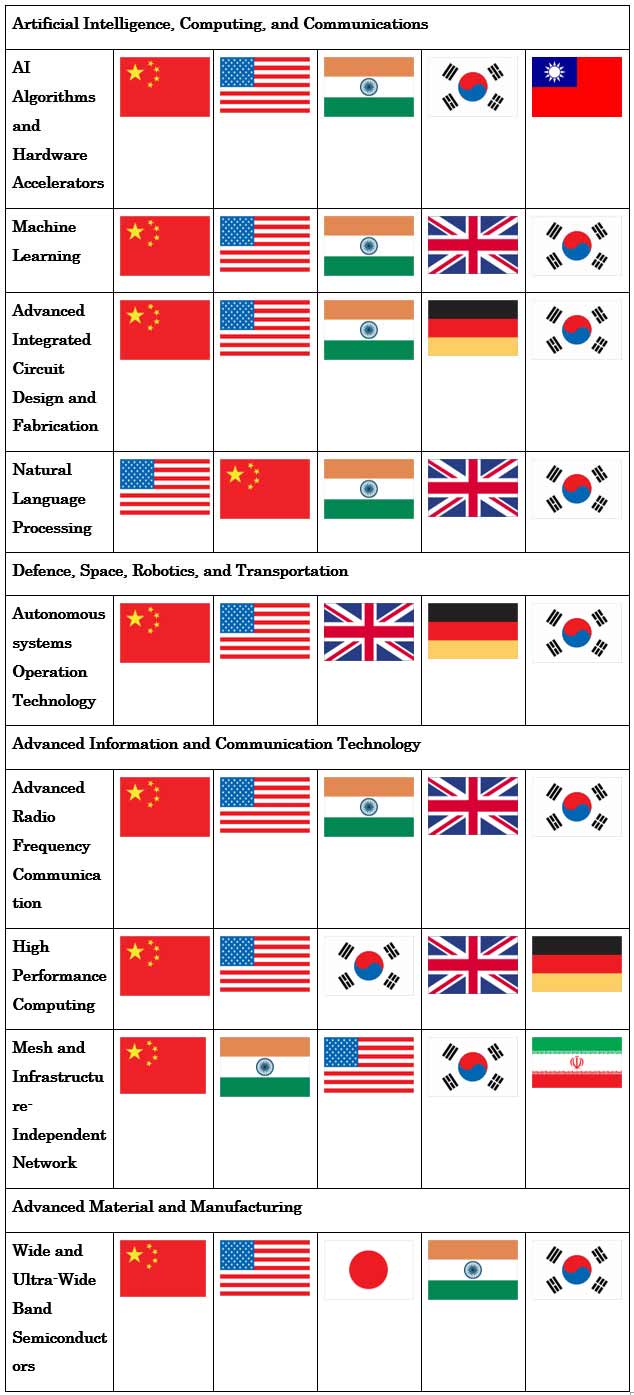
Source: ASPI Critical Technology Tracker[18]
This year, South Korea announced that it will create a US$34.1 billion fund to bolster its NGT capabilities in AI, semiconductors, batteries, and robotics, among others. These funds will be provided at low interest rates to private sector companies and will explore pathways through special purpose vehicles to partner with the big companies.[19] For 2025, a sum of US$79.1 million was allocated, marking an increase of 32.3 percent from the previous year.[20] The amount will be funnelled into 132 projects related to NGT's civilian and military applications, including micro-suicide drone systems and an amphibious mobile reconnaissance robot.[21]
Reiterating the importance of investment in NGTs, the Former Acting President, Choi Sang-mok, said, “Securing leadership in advanced technologies requires bold, large-scale investments.”[22] Similarly, while talking about the importance of NGTs, Park Sung-taek, the First Vice Industry Minister, emphasised that “[t]o lead the fast-evolving defense market, we need to achieve technological innovations through convergence of the cutting-edge technologies of the private sector, including AI and drones, and the defense sector.”[23]
All the focus on further strengthening the NGT ecosystem through proactive government intervention highlights three crucial considerations. First, as a middle power, South Korea sees its technological leverage and leadership in the domain as increasingly critical for its global strategic relevance, more so in the defence sector, and second, that the strategic leverage is directly linked to its economic security, given that it is a huge exporter of advanced technologies such as semiconductor chips and other ICT products. Finally, Korea sees the development of NGTs as critical for its national defence, considering its emerging threat.
Korea has also taken legislative steps to protect the NGT. It has promulgated acts such as the Special Measures Act on Strengthening and Protecting National High-Tech Strategic Industry Competitiveness.[24] Additionally, to promote the development of S&T Innovation for national defence purposes, the country passed the National Defense Science and Technology Innovation and Promotion Act on 1 April 2021.
The Act touches on three critical considerations: allowing private companies to own IP rights for jointly developed products, enabling them to sign contracts that limit liability if R&D (Research & Development) efforts fail, and allowing the private sector to take part in basic S&T, where the viability of the research is not determined.[25] Therefore, the competition to maintain its status as a leader in NGT is a matter of national and economic security. Korea sees S&T as a critical instrument for resolving pending issues, including the strengthening of national defence and security.[26]
South Korea's technological ecosystems are widely perceived to be world-class. According to a recent study by the Harvard Belfer Centre, the country stands fifth among twenty-five countries in key emerging technologies.[27] It scored better in some sectors, like semiconductors, in which it ranks fifth (see Figure 3). While the study highlighted Korea’s strength in semiconductors, it also showed its weaknesses in other critical technologies like AI (see Figure 2), quantum technologies, and space, where it barely reached the top 15 countries' list. This indicates that while these capabilities in some sectors may give the country an edge, its overall S&T ecosystem still lags behind its peers, like Japan, and even India. The following section focuses on the three NGTs: AI, semiconductors, and Robotics.
In 2019, for the first time under the Moon Jae-in administration, Korea released its National AI strategy, focusing on increasing investment in research, AI, semiconductors, and simplifying the regulatory framework for the industry. The Yoon Suk Yeol administration pushed the strategy to make Korea one of the three AI powerhouses.[28] The rationale was to harness AI to boost economic productivity amidst a shrinking population and to sustain technological prowess in the face of growing global competition. According to the Bank of Korea, AI integration will increase total factor productivity by 3.2 percent and increase GDP by 12.6 percent.[29] Therefore, the government plans to diffuse Industrial AI in manufacturing to 40 percent by 2030.[30]
Besides the civilian application of AI, Korea's Defense AI approach is also inspired by its comprehensive AI policy. Similar to how Korean businesses are considering AI for rapid economic growth, the defence industry is also looking at it to augment its capabilities. To realise this, the government has also created an exception under the Korean AI law, citing national security considerations.[31] Recently, Korean Defense Minister Lee Doo-hee vowed to “use advanced AI technology of artificial intelligence (AI) to create overwhelming military power and work on strengthening Korea’s defense capabilities and defense exports.”[32]
Figure 2: South Korea’s Ranking Across AI Parameters
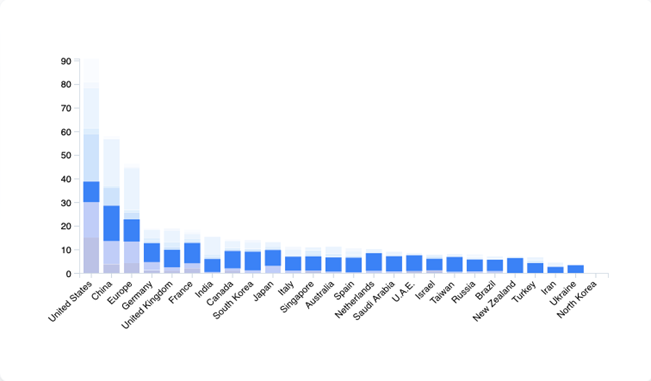

Source: The Harvard Belfer Centre’s Critical and Emerging Technologies Index[33]
The South Korean government has shown a keen interest in the semiconductor industry, given its edge in the sector. The country will leverage its industry and competitive edge in semiconductors to develop advanced weapons after recent warfare developments in Russia-Ukraine war, which has emphasised the strategic and tactical importance of specific military systems requiring advanced semiconductors. The government has taken many steps to this end. For instance, the Defence Acquisition Program Administration (DAPA) agency has established a dedicated unit overseeing the development, management, and certification of semiconductors in defence systems.[34] They also launched a public-private consultative body, focusing on strategising ways to strengthen the local industry. This body comprises representatives from the public and private sectors, including academia, businesses, and manufacturers, creating a good ecosystem for suggestions and feedback.[35] Additionally, mechanisms such as the AI security consultative group were launched in March of this year to study the security challenges that emerge from using AI.[36]
While emphasising the importance of the new unit, Seok Jung-gun, the DAPA minister, said that “the manned-unmanned teaming of assets, equipped with AI technology, is itself an assemblage of semiconductors, and as weapons evolve, demand for defence semiconductors will grow exponentially.”[37] Some of the financial announcements made by the government are aimed at achieving the goal of making Korea more competitive in the military semiconductor chips as well. For instance, the aim is to make Korea the world’s largest semiconductor hub by 2047, through a private-led model and support from the government.[38]
Figure 3: South Korea’s Ranking in Semiconductors
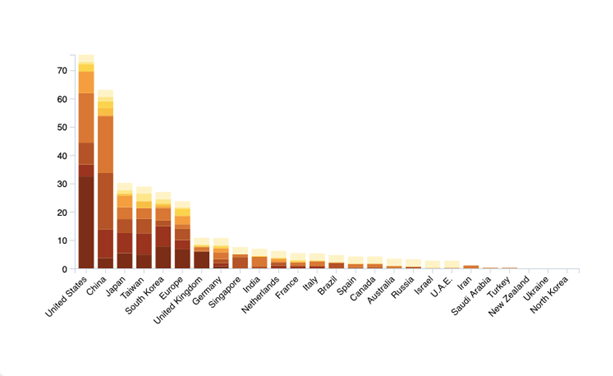
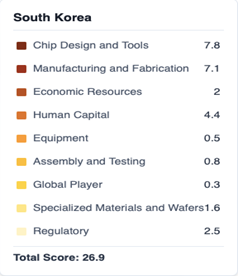
Source: The Harvard Belfer Centre’s Critical and Emerging Technologies Index[39]
As per DAPA, the state arms procurement agency focuses on semiconductor technologies development for defence manufacturing, like chips for military systems. Some of its projects focus on the development of semiconductors for small satellites, module platforms for Synthetic Aperture Radar used in drones, and the Active Electronically Scanned Array (AESA) radar.[40] Four out of five projects are expected to be undertaken this year.
Besides AI and semiconductor chips, South Korea has also paid attention to advanced robots in recent years. First, the country’s demographic challenges and technological innovation to achieve large-scale manufacturing have led to robotics adoption across sectors, ranging from production lines to coffee chains and restaurants. It is one of the most densely populated countries for deploying industrial robots, with around 1,000 bots per 10,000 factory workers, six times the global average.[41]
Figure 4: Density of Robots (Select Countries)
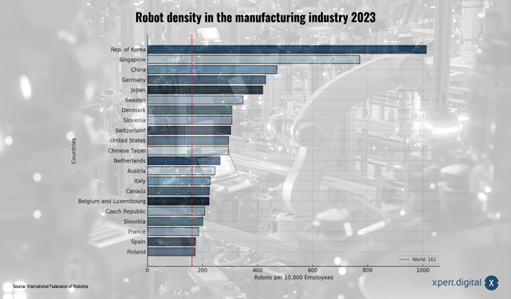
Notes:
- Robots installed per 10,000 people.
- South Korea has the highest density of robots in the world.
Source: International Federation of Robotics[42]
The development of the robotic ecosystem started way back in the early 2000s through the government’s legislative and policy support. The enactment of the Intelligent Robot Development and Distribution Promotion Act in 2008, followed by the 1st (2009-2013), 2nd (2014-2018), 3rd (2019-2023), and 4th (2024-2028)[43] Basic Plans, and the Intelligent Robot Law provided the framework for the development of the industry. These measures were supported by the establishment of the Korea Robot Industry Promotion Agency, which promotes the adoption of robots across industries.[44] Furthermore, the Ministry of Trade, Industry, and Energy recently included designated robotics and defence technologies as part of the strategic technologies list, recognising their immense economic potential and further boosting the defence robotics industry.
The Advanced robotics and manufacturing field is also part of one of the twelve critical emerging technologies approved by the PACST (Presidential Advisory Council on Science & Technology), subdivided into five key technologies: virtual manufacturing, human-robot interaction, autonomous movements, modulation of challenging movements, and components and operations of precise control movements.[45] Additionally, the government has introduced initiatives like the K-Humanoid alliance,[b] aimed at positioning South Korea as a global leader in humanoid robots by 2030 with strong state support. The alliance is estimated to attract an investment of US$685.12 million by 2030,[46] promising financial incentives to support legislative, policy, and institutional efforts.
According to the 2020 intelligent robot action plan, the government invested US$103 million and is expected to invest an additional sum of around US$2.26 billion by 2030 in the robotics sector to source almost 80 percent of its parts locally, compared to the current 44 percent.[47] Through these policy interventions, the government expects the local robot economy to grow from the current 5.6 trillion won in 2021 to 20 trillion won by 2030.[48] Given the attractiveness of the defence application of robotics, many companies are now increasingly catering to military needs.
With the Defence Manufacturing sector emerging as a national security priority and an engine of economic growth, the South Korean administration on both sides of the political spectrum has prioritised its modernisation. For instance, the progressive administration from 2017 to 2022 introduced the Fourth Industrial Revolution as a key policy objective.[49] During his term, Moon Jae-in launched the Defence Reforms 2.0 under the slogan of ‘advanced democratic military’ to address three challenges: geopolitical threats from its neighbour, the population issue, and the fourth industrial revolution.[50] The emphasis was on adapting to emerging technologies such as AI, Machine Learning (ML), automation, and information technology.
On the other hand, the Yoon Suk Yeol administration developed a Defense Innovation Strategy that stressed on developing industries, including defence manufacturing, emphasising technologies such as AI. Continuing the legacy, the new President Lee Jae Myung is also doubling down on investing in NGTs, promising to make South Korea one of the top three AI powers. His administration is encouraging the private sector through tax reforms and regulatory simplification. In an address, Lee said his “government will actively provide full-scale support for AI so that the Republic of Korea can leap forward as a fast-growing nation, making AI a core driver of economic growth.”[51]
South Korea has taken a whole-of-system approach to build next-generation technological capabilities by formulating a collaborative approach through public-private sector partnerships, which has been one of its strengths. This strategic approach helps the country invest more in its S&T sector by promoting the R&D of semiconductors, AI, quantum technology, advanced robotics and manufacturing, aerospace and marine technology, cybersecurity, and next-gen communication.[52] Furthermore, it enables civilian technologies to be used for military purposes, given that South Korea sees using S&T to resolve national pending issues, including national defence and security.[53] The country's Fifth Science and Technology Master Plan 2023-2027 reflects this vision to utilise S&T for economic growth and national security, creating a “A Bold Future Led by Science, Technology and Innovation”.[54] Recently, while addressing the inaugural K-Defense event, President Lee Jae Myung, said he “believe[s] that the defense industry will not only strengthen the security of the Republic of Korea, but also become one of its future growth engines”.[55]
The defence industry has enjoyed a strong and close relationship with the government since 1970, when Park Chung-hee started the defence industrialisation, which has continued till now. Coinciding with the aforementioned process, the security environment has been changing for Seoul, which has indirectly affected the pace of the process. However, since the 1990s, South Korea’s security considerations have influenced its defence industrialisation path to a larger extent. Scholars like Michael Raska have identified five factors affecting the country’s pursuit of security: the North Korean threat, the US’s defence transformation, Chinese military modernisation, the nature of the US-Korea alliance, and Korea’s quest for strategic autonomy.[56]
Given that the RMA is focused on NGT and the uncertainty of the future, South Korea has encouraged the acquisition of RMA-related assets through domestic procurement: one reason apart from the economic growth as to why the role of its defence industry becomes even more critical. Given its domestic industry's vital role as an economic growth engine and national security enabler, its part in the next phase of RMA becomes critical. Therefore, a prosperous defence technological ecosystem driven by next-generation technological innovation becomes key to the success of the RMA in South Korea.
Since the early 2000s, the defence industries have become a strong pillar of Korea’s economic prosperity and national security. Given its continuous emphasis on military modernisation and domestic production, South Korea has now accomplished a level of self-reliance, reducing its dependence on foreign countries for weapons imports. Currently, almost 70 percent of its defence equipment is sourced domestically. Additionally, its contribution to the economy is also increasing year-on-year. Korea’s arms imports have substantially decreased from 2015-2019 to 2020-2024 by 24 percent, and are expected to further decline given its increasing defence manufacturing capacity.[57] In this context, the government is modernising the defence industry by providing support and ensuring that the industry becomes more invested in next-generation technological innovation. For instance, the Korea Defense Capability (KDC) Programme announced in 2021 that it would focus on sourcing more domestically, spurring the local defence industry, and establishing a domestic supply chain. Taking on this issue, South Korea’s DAPA spokesperson said, “Korea Defense Capability promotes the acquisition of home-grown military equipment and the use of South Korean parts to strengthen the competitiveness of the domestic defence industry.”[58] This has been mainly possible due to the role of domestic private defence industries and government policies. However, the inclusion and integration of new technologies poses a unique challenge for the country, given their dual-use purposes. It is difficult to develop, considering the regulations and dynamic environment, particularly with NGTs like AI and unmanned systems. Recognising this challenge, South Korea is again looking at its private sector to step up and invest in developing new weapon equipment, such as unmanned vehicles, autonomous drones, and AI-powered weapons and systems.
While the South Korean government has laid out its vision regarding the Fourth Industrial Revolution (FIR) by enacting reforms and policy discussions, the country’s big conglomerates, known as chaebols, are implementing it. After assessing the government’s intention on the FIR, particularly in the defence manufacturing sector, all big companies have accelerated their pace of investment in the NGTs.
Companies like the Korea Aerospace Institute (KAI), HD Hyundai, and Hanwha have accelerated investments in NGT technologies. The Hanwha Group and its subsidiaries (Hanwha Aerospace, Hanwha Systems, and Hanwha Ocean) focus on integrating AI, particularly in developing AI-powered autonomous weapons. Subsidiaries like Hanwha Ocean are working on unmanned command and control ships with combat and reconnaissance capabilities.[59] KAI has also adopted a similar model, working with AI technology companies via collaboration and investments. Its investments are along the lines of developing AI pilots[c] and AI command and control systems in its autonomous military operations vehicles, including aircraft and UAVs. The company also plans to launch trials of its AI pilot concept by early next year. On the other hand, Hyundai is looking at AI integration to enhance its naval defence capabilities.
These conglomerates have adopted an important strategy to develop NGTs: buying, investing in, or collaborating with AI technology companies or startups. The objective is three-fold: first, focusing on fast-tracking the development of NGTs through either acquisition or R&D, second, to increase competitiveness in the defence sector, building top niche technological systems, and third, to expand its market in partnership with other players. Hanwha, for example, invested in ShieldAI, a US defence technology startup developing AI-based autonomous flight technology for drones, among others.[60] It has also collaborated with Milrem Robotics, an Estonian-based company, to create a Tracked-Robotic Combat Vehicle.[61] Similarly, KAI has invested US$4.1 million, holding a 9.87 percent stake in GenGenAI, an AI-based synthetic data solution company, and 13.3 billion won (Korean currency) in acquiring a 20.27 percent stake in Funzin, a company specialising in robotics and defence AI. Hyundai has also partnered with Palantir Technologies to co-develop advanced maritime systems and plans to launch them next year upon completion.[62] Besides AI, Korean conglomerates have also shown keen interest in technologies like robotics. Hyundai and Samsung's investments in this technology have increased substantially, as elaborated below. It is estimated that Robotics will make up almost 20 percent of Hyundai’s future business.[63] Recognising this potential, in 2022, Hyundai Motor bought Boston Dynamics (robotics company) from Softbank,[64] and similarly, Samsung also invested in companies such as Rainbow Robotics Co. Some of their products are either in the testing phase or under development.[65]
Besides major conglomerates, South Korea has also recognised the potential of small companies, particularly startups, in strengthening the country’s position as a technological leader in niche areas, such as quantum technologies and AI semiconductors, which also play a critical role in maintaining the country's national defence. In June 2025, the South Korean Government confirmed that the two companies, EYL’s ‘quantum random number generator technology’ and Boss Semiconductor’s ‘high-performance low-power AI semiconductor design technology for future mobility’ technology, were qualified as national strategic technologies.[66] Recognising the talent of these startups, many big conglomerates have also become interested and have started investing in them. This shows that chaebols are not oblivious to the startups or the robotic ecosystem.[67]
For example, Rainbow Robotics Co., backed by Samsung Electronics Co., is developing a multi-legged robot that is under trial in the Korean Army. The move highlights that South Korea’s NGT strategy is looking beyond just the big companies, including emerging startups working on cutting-edge technologies. Other companies like Doosan Mobility Innovation and Hyundai Motor Company are working to promote the development of hydrogen drones and vehicles in the military.[68] Seeing the demand for military drones, many companies operating in civilian sectors have decided to venture into the military drone sector. These companies include Nearthlab, Pablo Air, and This IS Engineering Inc. (TIF).[69] After the qualification, these startups can gain domestic and global advantages. At the national level, they get benefits such as military exemption, policy financing support, and an advantage while bidding for government programmes.[70] Recognition at the national level also helps them attract international collaborations and better investments, giving them the much-needed validation.
Table 2: South Korean Defence Conglomerates' and Startups’ Investments in Next-Generation Technologies
| South Korean Defence Companies/ Startups | Technology | Sectors (Air Force/Navy/Army) or Systems (Drones/Robots) | Project/Products |
| Hanwha | Artificial Intelligence and Robotics | Hanwha Aerospace: Air Force (Unmanned Aerial Vehicle and aircraft) Hanwha Ocean: Naval | Working on multiple domains such as unnamed ground vehicles, like Arion-SMET, a wheeled multipurpose uncrewed vehicle, next-generation autonomous vehicles, and robots. Developing Next Gen AI-powered Ships |
| Korea Aerospace Institute | Artificial Intelligence | Air Force (Unmanned Fighter Jets) | As part of Next-Generation Aerial Combat System (NGACS), one of its six key projects is to develop autonomous AI-pilot combat systems by 2030. |
| Hyundai | Artificial Intelligence | Naval Systems Hyundai Rotem: land systems | Co-developing TENEBRIS, an unmanned surface vessel (USV) for maritime operations. Working on developing an Unmanned Ground Vehicle |
| Samsung | Robotics | Samsung Electronics Co (Drone systems) | Invested in Rainbow Robotics Co., which is involved in developing autonomous and mobile robots |
| Doosan Mobility Innovation[71] | Urban air mobility | Hyundai Auto Group[72] (Drone systems) | Supply Hydrogen Fuel Cells to the Korean military |
| NearthLAB[73] | Unmanned Defense System | Drone Systems | Invested in developing drones with advanced AI software for easy manned-unmanned collaboration |
| Shift Dynamics INC. | Autonomous Systems | Air, Ground, and Maritime Systems | Focused on integrating the latest technologies, like ML, path planning, and computer vision in defence systems. |
| Pablo Air[74] | Unmanned Mobile Vehicles | Air Systems | Invested in producing Medium Altitude Unmanned Air Vehicles (MUAVs) |
| BOS Semiconductor[75] | Mobility Innovation | Semiconductor Technology | Focused on developing an autonomous and digitalised future of mobility with next-generation semiconductor technology |
Source: Author’s own
Strengthening South Korea’s military by adopting these technologies will make it a ‘smart military backed by AI technology and science’,[76] and equip it with the latest technologically advanced military weapons and systems to gain leverage on battlefields. One of the critical objectives of using technology is operational command, which assists military commanders in processing vast amounts of data related to reconnaissance and aiding military decision-making. The thinking behind this is that technology integration will lead to better responses, reducing the scope for human error. According to the Korea Research Institute for Defense Technology Planning and Advancement (KRIT), which was released in 2022, South Korea’s defence technologies, such as AI, were almost 93 percent comparable and just one or two years behind the US’s. [77]
One of the vital initiatives driving the adoption of technologies in Korea’s Military is the Defense Innovation 4.0. As stated in South Korea’s Defense White Paper 2022, the initiative aims to complement the goal of building ‘elite forces harnessing advanced technologies.’[78] It will make the military more effective, slimmer, and smarter, incorporating AI and other cutting-edge technologies. The white paper states that the goal will be achieved by formulating “forward-looking military strategies and operations concepts that align with the future security environment and develop AI-aided cutting-edge forces.”[79] The Defence Innovation 4.0 initiative consists of five focus areas and sixteen tasks, as shown in Figure 5.
Figure 5: Defence Innovation 4.0 Initiative
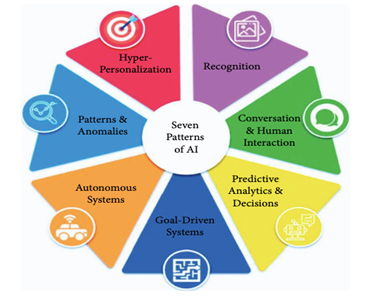
Source: 2022 Defense White Paper[80]
Under the Defence Innovation 4.0 Initiative, many new developments have occurred. In 2024, a Defense AI centre consisting of 110 civilian and military personnel was inaugurated. The centre focuses on technological development of AI-based manned-unmanned teaming systems, and battlefield situational awareness ‘on developing technologies related to AI-based manned-unmanned teaming systems and battlefield situational awareness.’ [81] The Ministry of National Defense (MND) is working with other ministries, such as the Ministry of Science and Technology, to strengthen cooperation in key sectors such as semiconductors, space, cyberspace, and AI, which will play a crucial role in future battlefields.[82] One of the initiatives undertaken to strengthen cooperation between the two ministries is the ICT Policy Council (started in 2016), whose objective is ‘to promote the application of digital technology and artificial intelligence to establish a strong, science and technology-based military, as well as to strengthen a cooperative system for ICT convergence between the two ministries.’[83]
Figure 6: The Seven Patterns of AI and its Application in Defence
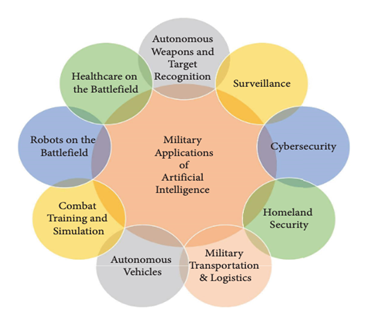
Source: Rashid et al.[84]
Besides, the MND is already undertaking an AI expansion programme at the unit and regional levels in the military (see Figure 6). Furthermore, as per reports, the Korean government is also exploring the benefits of machine learning and deep learning, leveraging large-scale military data to build a defence cloud or decision support system.[85] Samsung SDS and KT Cloud are some companies that are potential partners in this area.[86] Through this, the government aims to allow AI integration in the military to facilitate the development of AI weapon systems—the benefits of such an exercise range widely from maintenance and logistics management to enhancing warfighting strategies. For instance, AI applications can be used to train data to better predict the possible routes of attacks during an offensive or defensive operation. Some real experiments, such as Stormcloud, have shown the true extent of what AI in the military can achieve, with its ‘transformative’ potential.[87] Apart from experiments, AI use in wars through large AI assistants, such as in the Ukraine-Russia war, has also highlighted the technology’s immense potential to improve decision-making and precision targeting of military systems.[88]
Table 3: Adoption of Next-Generation Technologies in the Military
| Focus Areas for NGT Adoption | Plans | Initiatives |
| Military Education and Training | AI expansion at the unit and regional level[89] | Integration of Data and AI applications in security operations Educational lectures to enhance soldiers’ understanding of AI Training lectures on AI security education for soldiers by the Defense Counterintelligence Command, focusing on disseminating AI use in a special military environment. |
| Defence Management | Deploying Defensive Generative AI Establishment of Defence Integrated Data Centre | For translating military terminology and providing information on internal regulations[90] |
| Research and Innovation | Inter-ministerial coordination with the MICT[91] | Establishment of the ICT policy council,[92] areas of focus include: -Civilian-Military technology cooperation in Low Earth Orbit satellite communication -Expansion of domestic defence ICT products -Cooperation on AI technology convergence and ICT R&D |
| Military Culture | Military Education and Training Defence Data AI Proliferation Week (3 July – 10 July, 2024)[93] Generative Defense AI Service in the Military | Altair signed an MoU with the Korea Military Academy to nurture defence experts.[94] Focused on cultivating a strong culture of AI and Science & Technology in the military to build consensus among the forces. -Organise events to evangelise AI technology use in the military by displaying the its achievements on integration with military operations. -Holding events emphasising the use of data and AI technology to disseminate the latter in the military -Regular meetings between high defence officials (Defence Minister, officials from the forces, and the defence ministry) -Awareness about the use of AI, the reliability, and bias in generative AI Focused on the translation of military terminology, document summaries, and questions and answers about military regulations |
Source: Author’s own
Besides adopting AI for military research and innovation, South Korea also deploys AI and other technologies to improve its reconnaissance, surveillance, and monitoring capabilities. For instance, the Hansan battalion of the Army’s 5th Infantry Division, positioned alongside the Demilitarised Zone (DMZ), is actively using AI as part of its routine monitoring of border activity. The Unit has used AI technology with thermal observation to analyse real-time video footage to differentiate between humans and animals.[95] It is expected that with better training on increased data sets and algorithm improvement, the system will work more effectively in the future.
Apart from AI, there has been a tangential increase in the use of robotic applications in the military, given its benefits such as real-time data processing, increasing operational efficiency, and minimising human risks. South Korea’s defence market for robots is also witnessing growth driven by technological innovation and military modernisation. This demand is led by systems such as advanced robotics in surveillance, combat support, training and simulation, and reconnaissance operations. Besides the tactical and operational issues, the increasing adoption of robots also addresses the country's military personnel shortages and automation goals. It is estimated that the current domestic market size for robots for military applications is valued at US$13.82 billion for 2024 and is expected to reach US$35.15 billion by 2035.[96]
With the hilly terrain and human constraints, the military also uses robot cameras for border surveillance.[97] The military will expand these surveillance mechanisms to the coastal units and the eastern front line as part of the plans. Additionally, it plans to integrate these advanced technologies with all brigades by 2040.[98] One of the first testing brigades was launched in 2022, named the Army Tiger Demonstration Brigade. The TIGER brigade is short for ‘Transformative Innovation of Ground Forces Enhanced by the Fourth Industrial Revolution technology’. It is meant for future warfare, equipped with highly mobile armoured vehicles, high-tech gear, and AI-powered drones.[99] Lee Jong-sup, Minister for National Defense, said “[t]he brigade will utilise AI, manned-unmanned systems, and intelligence-based concepts. The brigade is experimenting with its structure to optimise these capabilities”, and will test new ‘concepts, structure and tactics’ utilising future technologies.[100] The military is also deploying robots for counter-terrorism operations. Developed under its 2022 plan, the military deployed a multi-legged robot for checking threats in a closed space, such as a building, before troop movements.[101]
Another vital area where the military is looking at integrating AI technologies is with Generative Defense AI, through modelling and simulation (M&S), to address some of the critical aspects of military operations and their routine work.[102] These can range from using AI in logistics management, resource allocation, and decision-making during peacetime. Integrating Hyperscale AI in South Korea’s Defence M&S presents immense potential to enhance the military’s operational effectiveness and strengthen national security.
South Korea considers defence exports to be one of the critical aspects of its economic growth. It realises that adapting to the new generation of weapons systems is vital to becoming a ‘defense powerhouse.’ The country aims to achieve the goal of a 5 percent share of global arms exports and become the world’s fourth-largest exporter by 2027.[103] Last year, exports amounted to US$9.5 billion, and annual operating profits were at US$1.58 billion. Besides, the strategic consideration behind increasing its defence exports is not merely shaped by financial benefits. By deepening its defence cooperation with other countries, South Korea aims to create strategic dependencies that can be leveraged for further deepening diplomatic and economic cooperation. The increasing defence exports also enhanced the goal of the subsequent governments to position the country as a strategic player in regional geopolitics. It uses its industrial and technological capabilities for defence exports to build its image as a security partner for like-minded countries.
Figure 7: South Korea’s Defence Exports Value (2000-2024, in US$ M)
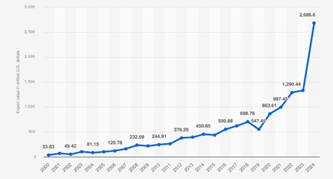
Source: Statista[104]
Besides export markets and military readiness, its acute declining demographics (as illustrated in Figure 8) are another critical driver for South Korea’s adoption of NGT, as shown in the military section. This challenge has been repeatedly acknowledged at the highest level. For example, Shin Won-sik, former South Korean Defence Minister, said, “[i]ntroducing unmanned systems is our top priority in order to maintain our ability to fight even if a lower birth rate reduces our troop strength.”[105] This challenge has become a serious national security issue for the country.[106]
Figure 8: Standing Troops Reduction Plan
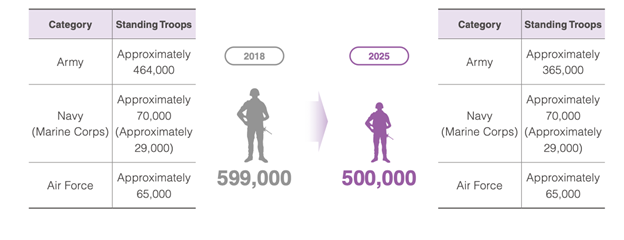
Source: 2018 Defense White Paper[107]
Thus, the country wants to adopt AI and unmanned/uncrewed systems in its military. The objective is to address the shrinking youth population challenge and, second, to enhance the military effectiveness. Seong Tae Jeong, Chief Technology Officer at Advanced Defense Science and Technology Research Institute under the Agency for Defense Development (ADD), said, “artificial intelligence and autonomous systems are particularly interested in addressing the country’s manpower shortages.”[108]
The country is also considering integrating the NGT into its industrial production, including the defence sector. According to a Federation of Korean Industries survey, four out of 10 conglomerates are considering investing in AI. Almost 43.9 percent of participants said that the biggest reason for the investment in AI was to drive production efficiency, particularly that of production lines and logistics systems.[109] Additionally, the Korean Ministry of Trade expects the technologies to boost productivity and reduce production costs by 30 percent and 20 percent, respectively.[110] For instance, companies like LG Innotek’s factory in Gumi operate fully automated with the latest innovations such as AI, robotics, and deep learning, typically eliminating variables hindering manufacturing competitiveness, such as safety accidents, breakdown losses, workforce, and failure costs.[111] As reported, AI-based inspection in the category has cut lead times, reduced the sampling inspection workforce by 90 percent, and slashed costs by half.[112]
Along with the private sector, the government will invest around US$2.6 billion in the manufacturing industry (integrating AI-based automated solutions). To promote integration of AI in manufacturing, an AI Autonomous Manufacturing Strategy was announced last year. The objective of the strategy is to achieve a growth of 30 percent in AI autonomous manufacturing diffusion, and 20 percent in manufacturing productivity by 2030. [113] Besides, the conglomerates, SMEs,[114] and startups[115] are also fast-tracking the use of AI technology in manufacturing. In the defence manufacturing sector, some companies like the HD Hyundai Samho want to become what it calls a Smart Shipyard under the Future of Shipyard Project, to improve productivity and cut shipbuilding time by 30 percent.[116] Focus areas for the AI integration include AI-based Hull support optimisation and an on-premises generative AI verification system.[117] Others also include Samsung Heavy Industries and Hanwha Ocean, focusing on digitisation efforts in the sector.[118]
One of the common threads of South Korea's defence industry is the presence of the chaebols in the supply chains, ranging from AI and robotics to semiconductors. They have effectively leveraged their industrial capabilities in the civilian sector, even in the critical and emerging technologies areas, to create a niche for themselves in the military industry. However, irrespective of their capabilities, there are some areas where they still lag; these include private sector R&D and the lack of skilled professionals required for innovation.
As part of its comprehensive strategy, the country has particularly emphasised R&D to remain the technological leader in the NGT and be globally competitive. The country’s R&D budget, allocated by the government and the private sector, highlights its importance. On the R&D front, Korea has taken concrete steps to bolster the twelve technologies, allocating almost US$23 billion for the next five years. A poll conducted by the Ministry of Trade, Industry and Energy showed that the R&D budget grew by 15.3 percent compared to 2023, showing a sound increase; however, compared to other countries, the case becomes clearer.[119] Current R&D numbers remain minuscule compared to large corporations in different countries; only 40 are in the top 2,000 R&D companies worldwide.[120]
To address this challenge, the government has worked closely with the private sector, which is facing serious challenges on the R&D front. In 2024, the government remained the largest investor in R&D at 23.6 percent, followed by the private and foreign funders, standing at 76.4 percent.[121] Among the private sector, companies, think tanks, and universities comprise 79.2, 11.7, and 9.1 percent, respectively. To further improve the situation, in its Fifth Science and Technology Master Plan (2023-2027), the government has emphasised facilitating structural and financial aid to the private sector. One of the plan’s critical objectives is to focus on making the R&D stronger by allowing companies to invest in high-risk projects, making regulations much simpler, expanding R&D support to scale, and securing the timeline of R&D budgets.[122]
Figure 9: Research and Development Allocated (2016-2023)

Source: Korea Defence Industry Association[123]
Enabling greater R&D by the private sector in the NGTs has been a challenge for the country, given its record where government institutions such as ADD have borne a bulk of the R&D burden. Incentivising the private sector to undertake R&D for future technologies will be a priority. The government would have to provide an amicable regulatory framework, financial incentives, institutional support, and better infrastructure access, such as military data, which, in its current status, is difficult.
While South Korea could leverage its private sector capabilities to develop critical military systems, this has not happened in the case of the NGT, due to the limited cooperation between the private sector and the government. Given that all technological advancements and competitiveness are interlinked with the development of other technologies, it poses a serious challenge for South Korea to continue having an edge in all fields. For instance, the robotics ecosystem development is closely linked with the future integration of AI applications; hence, an edge in the AI field acts as a catalyst, and a lag also pulls back the other sector.[124] In this context, the proliferation of Chinese robots seriously threatens South Korea’s domestic robotics industry.
The shortage of professionals across industry, academia, and businesses working on the NGT areas, in this case, the three key technologies: semiconductors, AI, and robotics, is a significant challenge that has emerged as a serious obstacle for South Korea. The lack of skilled and trained professionals has stalled the growth of its NGT, which has also impacted the progress and development of adopting these technologies in the defence sector. For instance, as per the Korea Semiconductor Industry Association, the number of skilled workers required by 2031 is 304,000; however, there is a current shortage of 54,000 people.[125] Besides the decreasing manpower, funding uncertainty has also become a concern for the country. The Yoon administration’s undertaking of research reforms, an attempt at reducing red tape and boosting transparency, created a lot of policy uncertainty about funding for NGT. In 2023, the government announced the decision to reduce the national R&D budget by US$20.4 billion, which is a 15 percent decline. The announcement derailed a lot of ongoing research work, particularly small projects (also called basic research projects) and wound up ‘harming research autonomy and predictability’.[126] However, after many protests from the research and scientific community, the decision was reversed.[127]
Many factors have come together in the last decade, increasing the perception of threat in South Korea. This includes China’s increasing military modernisation, the US’s changing defence posture, the shifting nature of the ROK-US alliance, and North Korea's growing military modernisation, with recent focus on asymmetrical and low-intensity military weapons. The country faces a serious security threat from these external factors and even serious internal demographic challenges. Therefore, to address these complex challenges and their implications for national security, the country has undertaken a serious regulatory and legislative step, enabling the defence manufacturing and the military to respond accordingly.
The government and the private sector have adopted an integrated civil-military strategy driven by its emphasis on becoming a leader in NGT, including AI, semiconductor chips, and robots. The Korean approach aims to instrumentalise these NGTs, replicating across its existing civil-military defence industrial ecosystem. The government seeks to sustain and focus on building technological innovation, which will act as a catalyst in pursuing RMA-oriented defence modernisation, military modernisation, and innovation.
Although the story of South Korea’s defence industrialisation and modernisation has been a case study for many countries that are trying to replicate the model, it also shows the challenges that exist. These include the limitations of scaling, workforce, and the private sector’s limited role in the NGT ecosystem, in which the country remains out of competition in many categories. Therefore, the challenge to succeed in the next phase of defence industrialisation will be an uphill battle more difficult than its earlier attempts.
Abhishek Sharma is Junior Fellow, Strategic Studies Programme, Observer Research Foundation.
The author thanks Himanshi Sharma for her research assistance.
All views expressed in this publication are solely those of the author, and do not represent the Observer Research Foundation, either in its entirety or its officials and personnel.
[a] Revolution in Military Affairs (RMA) refers to changes in the way wars are fought, organised and managed. It refers to the introduction and implementation of novel strategies and tactics, doctrines, force posture and other considerations such as procurements and acquisitions. See this: Moon Chung-in and Lee Jin-Young, “The Revolution in Military Affairs and the Defence Industry in South Korea,” Security Challenges 4, no. 4 (2008): 117–34. http://www.jstor.org/stable/26459813.
[b] The K-humanoid alliance consists of humanoid robot makers, AI experts, universities and other companies dealing with the parts. This alliance is divided into two groups, one focusing on AI development and the other on robot manufacturing. See this: “Newly Launched K-Humanoid Alliance to Develop Robots, AI,” Korea.net, April 11, 2025, https://www.korea.net/NewsFocus/Sci-Tech/view?articleId=269677
[c] AI pilot concept is the replication of a system trained in an artificial setting into an aircraft.
[1] Peter Banseok Kwon, Cornerstone of the Nation: The Defense Industry and the Building of Modern Korea under Park Chung Hee (Harvard University Press, 2024).
[2] Richard A Bitzinger, “The Defense Industry of the Republic of Korea,” in The Economics of the Global Defence Industry, ed. Keith Hartley and Jean Belin (Routledge, 2020), 378–95.
[3] Moon Chung-in and Lee Jin-Young, “The Revolution in Military Affairs and the Defence Industry in South Korea,” Security Challenges 4, no. 4 (2008): 117–34, http://www.jstor.org/stable/26459813.
[4] Moon and Lee, “The Revolution in Military Affairs and the Defence Industry in South Korea.”
[5] Moon and Lee, “The Revolution in Military Affairs and the Defence Industry in South Korea.”
[6] Moon and Lee, “The Revolution in Military Affairs and the Defence Industry in South Korea.”
[7] Michael Raska, “RMA Diffusion Path and Patterns in South Korea’s Military Modernisation,” The Korean Journal of Defense Analysis 23, no. 3 (2011): 361–85, https://doi.org/10.22883/kjda.2011.23.3.005.
[8] Raska, “RMA Diffusion Path and Patterns in South Korea’s Military Modernisation,” pp.374
[9] Raska, “RMA Diffusion Path and Patterns in South Korea’s Military Modernisation,” pp.375-378
[10] Helena Cooper et al., “Ukraine Shows It Can Still Flip the Script on How Wars Are Waged,” The New York Times, June 2, 2025, https://www.nytimes.com/2025/06/02/us/politics/ukraine-russia-drone-attack.html
[11]Amos Chapple, “How Ukraine’s ‘Spiderweb’ Drone Attacks May Change Modern Warfare,” RadioFreeEurope/RadioLiberty, June 2, 2025, https://www.rferl.org/a/russia-air-base-drone-attack/33431837.html
[12]Gordon Arthur, “South Korea Backtracks over Follow-on Apache Helicopter Buy,” Yahoo, July 9, 2025, https://www.yahoo.com/news/south-korea-backtracks-over-apache-112959983.html?guccounter=1&guce_referrer=aHR0cHM6Ly93d3cuZ29vZ2xlLmNvbS8&guce_referrer_sig=AQAAANlARNbgSFvipWpiczEMpdmsMvSnuIbneStribEkIU43JlWuSejHpxm-9U496O7rZKolJZagQJt6EdghTj-qQ5aGVGNHQA404SMUvlytFdgs-tJjg_qPfxxSznuaDWILCzWBzjL_YqSJpjDIDv87S7WZMSDK2-_arLaG756yZgnV
[13] “North Korea Drone Entered S Korea’s Presidential No-fly Zone: Army,” Al Jazeera, January 5, 2023, https://www.aljazeera.com/news/2023/1/5/north-korea-drone-entered-no-fly-zone-in-seoul-s-korea-military
[14] Sukjoon Yoon, “Emerging New Military Technologies in Northeast Asia and Implications for South Korean Defense Strategy,” DPI APCSS Security Nexus (2023), https://dkiapcss.edu/nexus_articles/emerging-new-military-technologies-in-northeast-asia-and-implications-for-south-korean-defense-strategy/
[15] Noah Tancer, “Space Forces – Korea Stands up First Forward Operating CJSpOC in Support of FS25,” United States Space Force, March 21, 2025, https://www.spaceforce.mil/News/Article-Display/Article/4131474/space-forces-korea-stands-up-first-forward-operating-cjspoc-in-support-of-fs25/
[16] Ministry of Science and ICT, “Korea to Announce National Strategy to Become a Technology Hegemon,” Ministry of Science and ICT, https://www.msit.go.kr/eng/bbs/view.do?mId=4&bbsSeqNo=42&nttSeqNo=746
[17] Ministry of Science and ICT, “Future of Korea in 2045 Driven by Science and Technology,” Ministry of Science and ICT, https://www.msit.go.kr/eng/bbs/view.do?sCode=eng&mId=4&mPid=2&pageIndex=&bbsSeqNo=42&nttSeqNo=449&searchOpt=&searchTxt=
[18] “Critical Technology Tracker,” Australian Strategic Policy Institute, https://techtracker.aspi.org.au/
[19] Lee Jae-eun and Kwak Chang-ryeol, “S. Korea to Launch $34 Billion Fund to Boost Semiconductor, AI Sectors,” The Chosun, March 5, 2025, https://www.chosun.com/english/industry-en/2025/03/05/5GSK6LANBFEJRM757BHHZUCHUA/
[20] Kim Na-young, “S. Korea to Spend 113.4 Bln Won on Developing Next-generation Defense Technologies,” Yonhap News Agency, April 20, 2025, https://en.yna.co.kr/view/AEN20250430003000320
[21] Kim, “S. Korea to Spend 113.4 Bln Won on Developing Next-generation Defense Technologies.”
[22] Lee Jae-eun and Kwak Chang-ryeol, “S. Korea to Launch $34 Billion Fund to Boost Semiconductor, AI Sectors,” The Chosun, March 5, 2025, https://www.chosun.com/english/industry-en/2025/03/05/5GSK6LANBFEJRM757BHHZUCHUA/
[23] Kim, “S. Korea to Spend 113.4 Bln Won on Developing Next-generation Defense Technologies.”
[24] “Korea Enacts Special Act to Protect and Foster National High-Tech Strategic Industry,” Kim & Chang, April 13, 2022, https://www.kimchang.com/en/insights/detail.kc?sch_section=4&idx=24744
[25] “South Korea Enacts the National Defense Science and Technology Innovation Promotion Act,” Yoon & Yang, June 2021, https://www.hwawoo.com/newsletter/2021_06_01/210601_eng.pdf
[26] Ministry of Science and ICT, The Fifth Science and Technology Master Plan (2023-2027) Announced, https://www.msit.go.kr/eng/bbs/view.do?sCode=eng&mId=4&mPid=2&bbsSeqNo=42&nttSeqNo=762
[27] Eric Rosenbach et al., “Critical and Emerging Technologies Index,” June 5, 2025, https://www.belfercenter.org/critical-emerging-tech-index#in-this-section-nav-2
[28] Ministry of Science and ICT, MSIT Presents Blueprint for Korea’s AI Innovation to Achieve AI G3 Status, https://www.msit.go.kr/eng/bbs/view.do?sCode=eng&mId=4&mPid=2&pageIndex=&bbsSeqNo=42&nttSeqNo=1040&searchOpt=ALL&searchTxt=&ref=newsletters.holoniq.com
[29] Lee Kyung-min, “New Finance Minister to Lead Lee Administration’s AI Initiative,” The Korea Times, June 20, 2025, https://www.koreatimes.co.kr/economy/20250630/finance-minister-nominee-koo-yun-cheol-to-lead-lee-administrations-ai-initiative
[30] Ministry of Trade, Industry, and Energy, Government of India, https://www.korea.net/Government/Briefing-Room/Press-Releases/view?articleId=7585&type=O&insttCode=A110412
[31] Sunha Bae and So Jeong Kim, “AI Security Strategy and South Korea’s Challenges,” CSIS, June 20, 2025, https://www.csis.org/analysis/ai-security-strategy-and-south-koreas-challenges
[32] Kim Ji-hwan, “Lee Doo-hee Vows to Enhance South Korea’s Defense Exports through AI Technology,” The Chosun, June 27, 2023, https://biz.chosun.com/en/en-policy/2025/06/27/BRIO72JFY5GS5FZUHG4XJEKAWI/
[33] Rosenbach et al., “Critical and Emerging Technologies Index.”
[34] Lee Minji, “Arms Agency Launches New Unit to Nurture Defense Chips,” Yonhap News Agency, September 20, 2024, https://en.yna.co.kr/view/AEN20240920002900315
[35] Lee, “Arms Agency Launches New Unit to Nurture Defense Chips.”
[36] “The National Intelligence Service (NIS) Conducted a Comprehensive Investigation into Five Years of AI Information Technology Projects at Public Institutions,” ET News, March 31, 2025, https://m.etnews.com/20250331000230?obj=Tzo4OiJzdGRDbGFzcyI6Mjp7czo3OiJyZWZlcmVyIjtOO3M6NzoiZm9yd2FyZCI7czoxMzoid2ViIHRvIG1vYmlsZSI7fQ%3D%3D
[37] Lee, “Arms Agency Launches New Unit to Nurture Defense Chips.”
[38] Ko Dong-hwan, “Korea Unveils Plan to Build $471 Bil. Mega Chip Cluster in Gyeonggi Province,” The Korea Times, January 15, 2024, https://www.koreatimes.co.kr/business/tech-science/20240115/korea-unveils-plan-to-build-471-bil-mega-chip-cluster-in-gyeonggi-province; “Korea to Expand Investment in Chip Industry to Secure Global Competitiveness,” The Korea Times, April 15, 2025, https://www.koreatimes.co.kr/economy/policy/20250415/south-korea-to-expand-investment-in-chip-industry-to-secure-global-competitiveness
[39] Rosenbach et al., “Critical and Emerging Technologies Index.”
[40] Lee, “Arms Agency Launches New Unit to Nurture Defense Chips.”
[41] Konrad Wolfenstein, “Industry & Service Robotics in South Korea: Challenges and Global Comparison with China, USA, Japan, Germany and the EU,” Xpert.Digital, January 3, 2025, https://xpert.digital/en/robotics-in-south-korea/
[42]Wolfenstein, “Industry & Service Robotics in South Korea: Challenges and Global Comparison with China, USA, Japan, Germany and the EU.”
[43]Kim Eun-jin, “Korean Gov’t Finalizes 4th Robot Plan,” Business Korea, January 17, 2024, https://www.businesskorea.co.kr/news/articleView.html?idxno=209659#google_vignette
[44] Kim Sigyun, Maeil Business Newspaper, June 10, 2024, https://www.mk.co.kr/en/business/11037532
[45] Ministry of Science and ICT, “Twelve Critical and Emerging Technologies Officially Confirmed,” Ministry of Science and ICT, https://www.msit.go.kr/eng/bbs/view.do?sCode=eng&mId=4&bbsSeqNo=42&nttSeqNo=943
[46] Lee Gyu-lee, “Korea Forms K-Humanoid Alliance,” The Korea Times, April 10, 2025, https://www.koreatimes.co.kr/business/tech-science/20250410/korea-forms-k-humanoid-alliance
[47] “S. Korea to Invest 3 Trillion Won in Robot Industry by 2030,” Emirates News Agency-wam, January 16, 2024, https://www.wam.ae/en/article/13puo0y-korea-invest-trillion-won-robot-industry-2030
[48] “S. Korea to Invest 3 Trillion Won in Robot Industry by 2030.”
[49] “4th Industrial Revolution Key Agenda for Moon’s Economic Policy,” The Korea Times, July 19, 2017, https://www.koreatimes.co.kr/southkorea/politics/20170719/4th-industrial-revolution-key-agenda-for-moons-economic-policy
[50] Ministry of National Defense, https://www.korea.kr/briefing/pressReleaseView.do?newsId=156452918
[51] Kim Eun-jung, “Lee Vows Full-Scale Support for AI to Create New Growth Engine,” Yonhap News Agency, June 20, 2025, https://en.yna.co.kr/view/AEN20250620005500315
[52] Ministry of Science and ICT, “The Fifth Science and Technology Master Plan (2023-2027) Announced,” Ministry of Science and ICT, https://www.msit.go.kr/eng/bbs/view.do?sCode=eng&nttSeqNo=762&pageIndex=&searchTxt=&searchOpt=ALL&bbsSeqNo=42&mId=4&mPid=2#:~:text=The%20Fifth%20S%26T%20Master%20Plan,yeol%20administration%20related%20to%20science
[53] Ministry of Science and ICT, The Fifth Science and Technology Master Plan (2023-2027) Announced
[54] Ministry of Science and ICT, The Fifth Science and Technology Master Plan (2023-2027) Announced
[55] Sarah Kim, “President Lee Vows to Korea a Global Defense Industry Powerhouse,” Korea JoongAng Daily, July 8, 2025, https://koreajoongangdaily.joins.com/news/2025-07-08/national/defense/President-Lee-vows-to-make-Korea-a-global-defense-industry-powerhouse/2348161
[56] Michael Raska, “Transforming South Korea’s Defence Capabilities,” East Asia Forum, May 29, 2012, https://eastasiaforum.org/2012/05/28/transforming-south-korea-s-defence-capabilities/
[57] Mathew George et al., “Trends in International Arms Transfer, 2024,” SIPRI, March 2025, https://www.sipri.org/sites/default/files/2025-03/fs_2503_at_2024_0.pdf
[58] “DAPA reveals ‘Korea Defense Capability’ Policy,” Janes, September 14, 2021, https://www.janes.com/osint-insights/defence-news/industry/dapa-reveals-korea-defense-capability-policy#:~:text=%E2%80%9CKorea%20Defense%20Capability%20promotes%20the,of%20procurements%20on%20national%20industry.
[59] Junnosuke Kobara, “South Korea Pushes AI to Bolster Military as Population Shrinks,” Nikkei Asia, November 5, 2024, https://asia.nikkei.com/Politics/Defense/South-Korea-pushes-AI-to-bolster-military-as-population-shrinks
[60] Park Yong-sun, “Hanwha Asset Management Invests in US Defense Startup Shield AI’s Growth,” Chosun Biz, March 13, 2023, https://biz.chosun.com/en/en-industry/2025/03/13/VHENK4ITNNAXXE2HPTJBL2QWGQ/#:~:text=Earlier%2C%20Shield%20AI%20announced%20on,drones%20and%20autonomous%20driving%20systems.
[61] Kim Nam-hee and Lee Jae-eun, “South Korean Defense Giants Bet Big on AI-powered Military Tech,” The Chosun Daily, March 12, 2025, https://www.chosun.com/english/industry-en/2025/03/12/QHC7AJBE3ZAFFIAAD2T3VSJAUI/
[62] Kim and Lee, “South Korean Defense Giants Bet Big on AI-powered Military Tech.”
[63] Jung-Eun Shin, “Hyundai-owned Boston Dynamics, Toyota Team up for Humanoid Robots,” The Korea Economic Daily, October 22, 2024, https://www.kedglobal.com/future-mobility/newsView/ked202410170014
[64] “Hyundai Motor Group Completes Acquisition of Boston Dynamics from Softbank,” Boston Dynamics, June 21, 2021, https://bostondynamics.com/news/hyundai-motor-group-completes-acquisition-of-boston-dynamics-from-softbank/
[65] Shin, “Hyundai-owned Boston Dynamics, Toyota Team up for Humanoid Robots.”
[66] Lee Jong-hyun, “Korea Identifies Quantum Random Number Generator and AI Semiconductor Design as Strategic Technologies,” Chosun Biz, June 24, 2025, https://biz.chosun.com/en/en-science/2025/06/24/HW5DA76ECZDAHA4T6YPCPUOSEY/
[67] Christopher Helman, “How South Korea’s Chaebols Are Pushing the Robotics Revolution,” Forbes, June 12, 2025, https://www.forbes.com/sites/christopherhelman/2025/06/12/how-south-koreas-chaebols-are-pushing-the-robotics-revolution/
[68] “Doosan Mobility Innovation to Cooperate with Government to Expand the Application of Hydrogen Fuel Cell Power,” Doosan Mobility Innovation, June 17, 2020, https://www.doosanmobility.com/en/about-us/news-events/news/21000013?page=5&searchKeyword
[69] Eun-Yi Ko, “South Korean Drone Startups Rush to Join Military Drone Race,” The Korea Economic Daily, April 9, 2024, https://www.kedglobal.com/korean-startups/newsView/ked202404080020
[70] Matt Swayne, “South Korea Recognizes Quantum And AI Chip Designs As National Strategic Technologies,” Quantum Insider, June 24, 2025, https://thequantuminsider.com/2025/06/24/south-korea-recognizes-quantum-and-ai-chip-designs-as-national-strategic-technologies/
[71] Lim Chang-won, “Doosan Mobility Innovation Selected as Supplier of Military Hydrogen-powered Drones,” AJP News Agency, June 16, 2020, https://www.ajupress.com/view/20200616170643918
[72] “Doosan Mobility Innovation to Cooperate with Government to Expand the Application of Hydrogen Fuel Cell Power,”
[73]“Opening the Era of Unmanned Defense System,” NearthLAB, https://www.nearthlab.com/en/industry/defense.php
[74] Cho Kwang-hyun, Maeil Business Newspaper, January 30, 2024, https://www.mk.co.kr/en/it/10932762
[75] BOS Semiconductors, “Driving the Future of Automotive Expanding Mobility,” https://www.bos-semi.com/about-us
[76] “Defense Ministry Seeks to Expand Data, AI Technology in Military,” Yonhap News Agency, July 3, 2024, https://m-en.yna.co.kr/view/AEN20240703003800315
[77] Kang Yoon-seung, “S. Korea’s AI Defense Technologies Catching up with U.S. Equivalents: Report,” Yonhap News Agency, January 26, 2022, https://en.yna.co.kr/view/AEN20220126004000325
[78] Ministry of National Defense, 2022 Defense White Paper, https://www.mnd.go.kr/user/mndEN/upload/pblictn/PBLICTNEBOOK_202307280406019810.pdf
[79] Ministry of National Defense, 2022 Defense White Paper.
[80] “Defense Ministry Launches AI Research Center,” Korea JoongAng Daily, April 1, 2024, https://koreajoongangdaily.joins.com/news/2024-04-01/national/defense/Defense-Ministry-launches-AI-research-center-/2015731
[81] “Defense Ministry Launches AI Research Center.”
[82] “Defense Ministry Launches AI Research Center”; Lee, “Defense, Science Ministries to Strengthen Cooperation for Smarter Military.”
[83] Ministry of National Defense, Republic of Korea, https://www.mnd.go.kr/user/boardList.action?command=view&page=6&boardId=I_8576246&boardSeq=I_10811731&titleId=null&siteId=mndEN&id=mndEN_020600000000&column=null&search=null
[84] Adib Bin Rashid et al., “Artificial Intelligence in the Military: An Overview of the Capabilities, Applications, and Challenges,” International Journal of Intelligent Systems (2023):1–31, https://doi.org/10.1155/2023/8676366
[85] “Korea Eyes AI Integration to Bolster Military Capabilities,” Pulse, July 10, 2025, https://pulse.mk.co.kr/news/all/11364398
[86] “Korea Eyes AI Integration to Bolster Military Capabilities.”
[87] “How AI is Changing Warfare,” The Economist, June 20, 2024, https://www.economist.com/briefing/2024/06/20/how-ai-is-changing-warfare
[88] Ministry of National Defense, Republic of Korea, https://www.mnd.go.kr/user/boardList.action?command=view&page=5&boardId=I_8576246&boardSeq=O_367527&titleId=null&siteId=mndEN&id=mndEN_020600000000&column=null&search=null
[89] Ministry of National Defense, Republic of Korea.
[90] “Defense Ministry Seeks to Expand Data, AI Technology in Military,” Yonhap News Agency, July 3, 2024, https://m-en.yna.co.kr/view/AEN20240703003800315
[91] Ministry of National Defense, Republic of Korea, https://www.mnd.go.kr/user/boardList.action?command=view&page=6&boardId=I_8576246&boardSeq=I_10811731&titleId=null&siteId=mndEN&id=mndEN_020600000000&column=null&search=null
[92] Ministry of National Defense, Republic of Korea.
[93] Ministry of National Defense, Republic of Korea, https://www.mnd.go.kr/user/boardList.action?command=view&page=5&boardId=I_8576246&boardSeq=O_365805&titleId=null&siteId=mndEN&id=mndEN_020600000000&column=null&search=null
[94] “Altair Signs MoU with Korea Military Academy to Advance AI Innovation in Defense,” Altair, April 14, 2025, https://altair.com/newsroom/news-releases/altair-signs-mou-with-korea-military-academy-to-advance-ai-innovation-in-defense
[95] “S. Korean Border Troops Harness AI-powered Surveillance Tech against N.K. Threats,” Yonhap News Agency, May 23, 2024, https://en.yna.co.kr/view/AEN20240523002700315
[96] Edwyne Fernandes, “South Korea Robots for Military Applications Market Overview: Key Trends and Emerging Technologies (2026-2032),” LinkedIn, June 24, 2025, https://www.linkedin.com/pulse/south-korea-robots-military-applications-market-i71uc/
[97] “S. Korean Border Troops Harness AI-powered Surveillance Tech against N.K. Threats,” Yonhap News Agency, May 23, 2024, https://en.yna.co.kr/view/AEN20240523002700315
[98] Junnosuke Kobara, “South Korean Army Showcases Drone-equipped Future Fighting Force,” Nikkei Asia, January 14, 2023, https://asia.nikkei.com/Business/Technology/South-Korean-army-showcases-drone-equipped-future-fighting-force
[99] Chae Yun-hwan, “S. Korea’s Advanced Army Unit, U.S. Stryker Team Hold Joint Drills near Border with N. Korea,” Yonhap News Agency, January 14, 2023, https://en.yna.co.kr/view/AEN20230113005700325
[100] Jon Grevatt, “RoK Army Sets up ‘Army Tiger Demonstration Brigade’ to Lead AI Integration,” Janes, August 19, 2022, https://www.janes.com/osint-insights/defence-news/defence/rok-army-sets-up-army-tiger-demonstration-brigade-to-lead-ai-integration
[101] “Korea Test-deploys Multi-legged Counter-terrorism Robot,” Emirates News Agency-Wam, August 12, 2024, https://www.wam.ae/en/article/142amki-korea-test-deploys-multi-legged-counter-terrorism
[102] Youngjoon Lee et al., “ROK Defense M&S in the Age of Hyperscale AI: Concepts, Challenges, and Future Directions,” arXiv.org, October 1, 2024, https://arxiv.org/html/2410.00367v1#S3
[103] Song Sang-ho, “S. Korea Aims for 5 Pct Share in Global Arms Market by 2027,” Yonhap News Agency, November 24, 2022, https://en.yna.co.kr/view/AEN20221124007300325
[104]"Value of Arms and Ammunition Exported from South Korea from 2000 to 2024 (in Million U.S. Dollars)," Chart, Statista, May 16, 2025, https://www.statista.com/statistics/1368208/south-korea-arms-and-ammunition-export-value/
[105] Kobara, “South Korea Pushes AI to Bolster Military as Population Shrinks.”
[106] Abhishek Sharma and Torunika Roy, “South Korea’s Declining Demographics: A National Security Issue,” Observer Research Foundation, November 11, 2024, https://www.orfonline.org/expert-speak/south-korea-s-declining-demographics-a-national-security-issue
[107] Ministry of National Defense, 2018 Defense White Paper, https://www.mnd.go.kr/user/mndEN/upload/pblictn/PBLICTNEBOOK_201908070153390840.pdf
[108] Allyson Park, “South Korea Looking for More Military Tech Cooperation with Allies,” National Defense, March 28, 2025, https://www.nationaldefensemagazine.org/articles/2025/3/28/south-korea-looking-for-more-military-tech-cooperation-with-allies
[109] Park Han-na, “4 in 10 Korean Companies Considering AI Investment,” The Korea Herald, July 8, 2024, https://www.koreaherald.com/article/3430354
[110] Kang Yoon-seung, “S. Korea to Invest 3.7 Tln Won in Projects to Apply AI in Manufacturing Sector,” Yonhap News Agency, October 28, 2024, https://en.yna.co.kr/view/AEN20241028002600320
[111] Jie Ye-eun, “Robots, AI and Zero Dust: Inside LG Innotek’s ‘Dream Factory’,” The Korea Herald, April 20, 2025, https://www.koreaherald.com/article/10469366
[112] Jie, “Robots, AI and Zero Dust: Inside LG Innotek’s ‘Dream Factory’.”
[113]“MOTIE Launches AI Industrial Policy Committee, Laying out Roadmap for AI Era,” Korea.net, May 8, 2024, https://www.korea.net/Government/Briefing-Room/Press-Releases/view?articleId=7391&type=O
[114] “South Korea Unveils AI Manufacturing Guidelines to Support SMEs,” Asia Manufacturing Review, June 19, 2025, https://www.asiamanufacturingreview.com/news/south-korea-unveils-ai-manufacturing-guidelines-to-support-smes-nwid-1785.html
[115] John, “Korean Startups Developing AI for Manufacturing Industries,” SeoulZ, October 13, 2023, https://www.seoulz.com/korean-startups-developing-ai-for-manufacturing-industries/
[116] Sara Kosmajac, “ABS, HD Hyundai Join Forces on AI-backed Smart Shipyard Vision,” Offshore Energy, June 19, 2025, https://www.offshore-energy.biz/abs-hd-hyundai-join-forces-on-ai-backed-smart-shipyard-vision/
[117] Dom Magli, “KR, HD Hyundai Samho Launch AI Project for Shipbuiding,” Port Technology International, June 17, 2025, https://www.porttechnology.org/news/kr-hd-hyundai-samho-launch-ai-project-for-shipbuilding/
[118] Kosmajac, “ABS, HD Hyundai Join Forces on AI-backed Smart Shipyard Vision.”
[119] Lee Ju-hyeong, “Samsung Leads South Korea’s Record R&D Investment, Deepening Corporate Concentration,” Chosun Biz, June 12, 2025, https://biz.chosun.com/en/en-policy/2025/06/12/Q3RJJEJUKFCZTBMEBGBTZY6Q6I/
[120] Lee, “Samsung Leads South Korea’s Record R&D Investment, Deepening Corporate Concentration.”
[121] Lee Jihae, “Domestic R&D Spending as % of GDP Ranked No. 2 in 2023,” Korea.net, December 30, 2024, https://www.korea.net/NewsFocus/Sci-Tech/view?articleId=264121
[122] Ministry of Science and ICT, The Fifth Science and Technology Master Plan (2023- 2027) Announced, https://www.msit.go.kr/eng/bbs/view.do?sCode=eng&mId=4&mPid=2&bbsSeqNo=42&nttSeqNo=762
[123] "Research and Development (R&D) Investments Made by the Defense Industry in South Korea from 2016 to 2023 (in Billion South Korean Won)," Statista, December 19, 2024, https://www.statista.com/statistics/1366640/south-korea-defense-industry-rnd-investments/
[124] “What Korea’s Robotics Industry Fears Most,” Asian Robotics Review, https://asianroboticsreview.com/home733-html
[125] Kim Boram, “DGIST President Vows to Grow DGIST as World-leading Research Univ,” Yonhap News Agency, March 19, 2024, https://en.yna.co.kr/view/AEN20240318007600320
[126] Lee Jong-hyun, “Korean Ministry of Science and ICT Apologizes for R&D Budget Cuts and Plan Recovery,” Chosun Biz, June 19, 2025, https://biz.chosun.com/en/en-science/2025/06/19/N6SDBHRBHFEVTCP4MOF6PGVEZE/
[127] Moon Joon-hyun, “National Assembly Approves Historic 15% Cut to R&D Budget,” The Korea Herald, December 22, 2023, https://www.koreaherald.com/article/3288777
The views expressed above belong to the author(s). ORF research and analyses now available on Telegram! Click here to access our curated content — blogs, longforms and interviews.
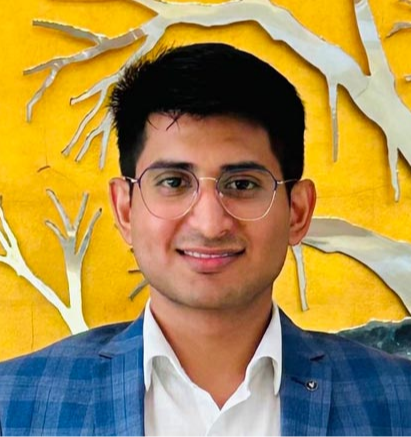
Abhishek Sharma is a Junior Fellow with the ORF’s Strategic Studies Programme. His research focuses on the Indo-Pacific regional security and geopolitical developments with a ...
Read More +